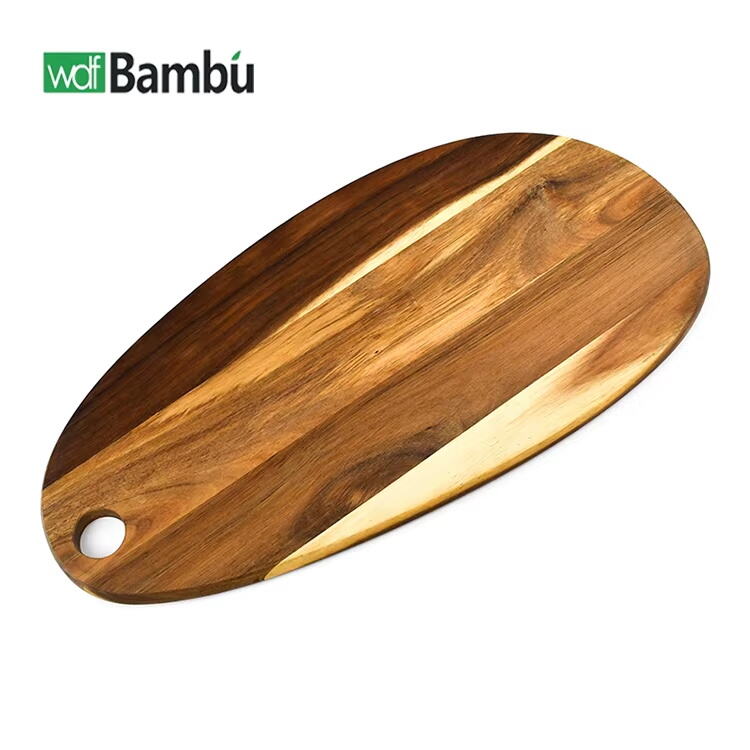Wprowadzenie
Krótkie wyjaśnienie, dlaczego deski do krojenia z bambusa są popularnym wyборem.
Płyty do krojenia z bambusa stają się obecnie bardzo popularne na kuchniach na całym świecie, ponieważ łączą estetykę z ciekawymi właściwościami naturalnymi. Osoby dbające o ekologiczne podejście często wybierają bambus na wyposażenie kuchni, ponieważ rośnie znacznie szybciej niż inne materiały. Taki szybki wzrost czyni go jednym z odnawialnych zasobów, na które możemy liczyć z perspektywy czasu. Co jeszcze można powiedzieć o bambusie? Jest lekki, ale jednocześnie bardzo wytrzymały. Jego powierzchnia nie jest zbyt szkodliwa dla ostrzy noży, co oznacza, że kucharze mogą swobodnie kroić, nie obawiając się uszkodzenia narzędzi podczas codziennej przygotowywania posiłków. To, co naprawdę wyróżnia bambus, to jego naturalna odporność na bakterie. Płyty plastikowe mają tendencję do zatrzymywania zarazków w drobnych ryskach, natomiast bambus nie pozwala im się zagnieździć dzięki gęstemu wzorowi włókien. Ma to znaczenie, dlatego więcej domowych kucharzy decyduje się wymienić swoje stare plastikowe płyty na takie, które lepiej wyglądają, lepiej funkcjonują i są bardziej przyjazne dla planety.
Ważność wyboru odpowiedniej deski do krojenia z bambusa zgodnie z własnymi potrzebami.
Wybór odpowiedniej deski do krojenia z bambusa ma ogromne znaczenie, jeśli chodzi o skuteczność działania na kuchni i faktyczne cieszenie się czasem przygotowywania posiłków. Różne zadania wymagają różnych desek. Podczas krojenia warzyw najlepiej sprawdza się deska o gładkiej powierzchni, którą łatwo przetrzeć. Natomiast przy obsłudze mięsa warto poszukać desek z drobnymi rowkami, które zbierają soki i zapobiegają brudzeniu blatu. Dobre deski bambusowe radzą sobie z praktycznie każdą pracą, przekształcając gotowanie w sprawność zamiast frustrację. Ludziom zależy na takich aspektach, jak łatwość czyszczenia, rozmiar dopasowany do dostępnej przestrzeni oraz to, czy deska nie zajmuje zbyt dużo miejsca w miejscu przechowywania. Połączenie tych praktycznych kwestii z rzeczywistymi potrzebami sprawia, że deska staje się częścią codziennego kuchennego rytuału zamiast leżeć nieużywana w szafce. Dzięki temu użytkownicy z czasem zyskują lepsze doświadczenia związane z przygotowywaniem posiłków.
Rozważ rozmiar i kształt
Czynniki do uwzględnienia: dostępna przestrzeń kuchenna, częstotliwość użytkowania i potrzeby przygotowywania jedzenia
Rozmiar ma znaczenie przy wyborze deski do krojenia z bambusa, a ilość rzeczywiście dostępnej przestrzeni w naszej kuchni powinna być punktem wyjścia. Duże deski po prostu nie mieszczą się dobrze w małych kuchniach, gdzie zaczynają dominować na blatach i powodować bałagan. Osoby borykające się z ograniczoną powierzchnią często stwierdzają, że mniejsze deski sprawdzają się lepiej, ponieważ pozostawiają więcej wolnej przestrzeni. Częstotliwość gotowania również odgrywa rolę. Poważni amatorzy gotowania zazwyczaj potrzebują większych powierzchni, ponieważ krojenie warzyw na kilka dań staje się irytujące, jeśli trzeba stale przesuwać rzeczy po małej desce. Spojrzenie na to, jaki rodzaj przygotowań kulinarnych występuje najczęściej, pomaga określić, jaki kształt deski będzie najbardziej odpowiedni. Niektóre czynności krojenia naprawdę wymagają określonych wymiarów, aby wykonać je poprawnie. Dobry dobór deski może przekształcić codzienne gotowanie w płynniejszy proces zamiast walki z niewystarczającym sprzętem.
Różne kształty i rozmiary dla różnych zadań
Deski do krojenia bambusowe dostępne są w różnych kształtach i rozmiarach, każda zaprojektowana z myślą o innym zastosowaniu w kuchni. Prostokątne deski świetnie sprawdzają się w codziennym krojeniu, natomiast okrągłe są częściej wybierane podczas układania potraw lub wykonywania konkretnych zadań, takich jak rozwałkowanie ciasta pizzy. Wielkość deski również ma znaczenie. Duże deski są praktyczne przy pracy z mięsem, ponieważ zapewniają dużo miejsca i pozwalają uniknąć rozlania się soku po całej powierzchni. Mniejsze deski z kolei lepiej sprawdzają się w szybkich, drobnych pracach, takich jak krojenie ziół lub mieszanie dekoracyjnych dodatków. Zrozumienie, co najlepiej sprawdza się w różnych sytuacjach, pomaga osobom wybierać odpowiednią deskę, która będzie odpowiadać ich stylowi gotowania i częstotliwości użytkowania podczas codziennych posiłków.
Szukaj trwałości i siły
Ważność grubości i konstrukcji
Grubość ma znaczenie przy wyborze deski do krojenia z bambusa, podobnie jak sposób jej wykonania, ponieważ te czynniki istotnie wpływają na trwałość i odporność na codzienne zużycie. Grubsze deski zazwyczaj lepiej opierają się wyginaniu niż cienkie, które wielu ludzi kupuje odruchowo. Niektóre deski są wykonane z klejenia kilku warstw (bambus laminowany), co zwiększa ich początkową wytrzymałość, jednak deski z pełnego bambusa, bez tych sklejonych połączeń, w rzeczywistości lepiej się sprawdzają przez wiele lat, nie rozpadając się na stykach. Warto również zwracać uwagę na dodatkowe wzmocnienie wokół krawędzi, ponieważ pomaga to zapobiegać powstawaniu rys po wielu cięciach i krojeniu. Wydanie większej kwoty na początku na jakość wykonania oznacza mniej kłopotu później, gdy wymiana zużytych desek co kilka miesięcy staje się uciążliwa.
Jak gęstość bambusa wpływa na trwałość
Gęstość bambusa ma kluczowe znaczenie dla długości trwania deski do krojenia. Weźmy na przykład bambus moso, który należy do najgęstszych dostępnych odmian, dlatego właśnie producenci często go wybierają, tworząc trwałe deski. Wyższa gęstość nadaje tym deskom rzeczywistą wytrzymałość, a także pomaga im skutecznie oprzeć się irytującym zarysom po nożu, które z czasem się kumulują. Większość certyfikatów jakości traktuje gęstość jako jeden z głównych wskaźników starannej pracy przy produkcji wyrobów z bambusa. Kiedy ktoś wybiera deskę do krojenia wykonaną z gęstego bambusa, inwestuje w produkt, który potrafi wytrzymać codzienne użycie w kuchni, nie tracąc swojego wyglądu czy funkcjonalności nawet po wielu miesiącach regularnego krojenia i siekania.
Sprawdź gładkość i wykończenie
Ważność gładkiej powierzchni dla ochrony noży i higieny.
Jakość powierzchni deski do krojenia bambusowej odgrywa dużą rolę przy utrzymaniu ostrości noży oraz przy zachowaniu standardów higieny żywności. Deski dobrze wykończone nie powodują tak szybkiego tępienia ostrzy, ponieważ zapewniają płaską powierzchnię, na której krojenie może odbywać się równomiernie, bez uszkadzania krawędzi ostrza w czasie. Pod względem czystości wygrywają zdecydowanie deski gładkie. Badania wykazują, że chropowate miejsca i nierówności na powierzchniach do krojenia faktycznie zatrzymują więcej zarazków, co zwiększa ryzyko zanieczyszczenia krzyżowego między produktami. Czyszczenie jest również znacznie prostsze na gładkich powierzchniach – testy wykazały, że po umyciu pozostaje około 30% mniej bakterii w porównaniu do chropowatych alternatyw. Dla każdego, kto dba o bezpieczeństwo kuchenne, różnica w fakturze powierzchni rzeczywiście ma duży wpływ na zapobieganie chorobom wynikającym z zanieczyszczonych miejsc przygotowywania żywności.
Jakość wykończenia: olejowanie i szczelność.
Utrzymanie desek do krojenia z bambusa w odpowiednim stanie poprzez regularne smarowanie i impregnację pozwala znacznie wydłużyć ich trwałość. Bez tego typu konserwacji deski mają tendencję do pękania z biegiem czasu oraz wchłaniania nieprzyjemnych zapachów pochodzących z różnych produktów spożywczych. Większość osób bez trudu znajdzie w sklepach lub w internecie kilka opcji środków do tego przeznaczonych, w tym olej mineralny czy produkty na bazie wosku pszczeliny, wytwarzane specjalnie do powierzchni kuchennych. Dobrym sposobem jest nanoszenie świeżego oleju mniej więcej raz na miesiąc, w zależności od intensywności użytkowania deski. Regularne smarowanie utrzymuje estetyczny wygląd powierzchni i chroni ją przed uszkodzeniami, dzięki czemu piękne wzory słoja drewna nie zanikają po kilku miesiącach codziennego użytkowania.
Zapewnij Zrównoważoność
Ważność Wybierania Ekologicznego, Zrównoważonego Bambusa
Wybierając narzędzia kuchenne, zwróć uwagę na materiały, które naprawdę pomagają środowisku, zamiast mu szkodzić. Bambus wyróżnia się jako świetna opcja, ponieważ jest bardzo przyjazny dla planety i odnawia się w rekordowym tempie. Według danych USDA, podczas gdy większość twardych gatunków drewna potrzebuje dekad, by osiągnąć dojrzałość, bambus rośnie średnio o około 35 cali dziennie. Taka szybkość wzrostu pozwala rolnikom na regularne jego zbieranie, bez wycinania lasów czy wyczerpywania zasobów. Wybór łyżek i innych przyborów kuchennych z bambusa nie tylko chroni nasze lasy, ale także ma sens ekonomiczny, ponieważ nie trzeba czekać lat między jednym a drugim zbiorem, jak to ma miejsce przy tradycyjnym drewnie.
Jeśli ktoś chce upewnić się, że jego bambusowa deska do krojenia faktycznie pochodzi ze źródeł zrównoważonych, warto sprawdzić, czy posiada certyfikat FSC. Etykieta Forest Stewardship Council oznacza, że bambus został zebrany w sposób chroniący lasy, wspierający lokalne społeczności i zapewniający dostępność zasobów dla przyszłych pokoleń. Gdy konsumenci wybierają tak certyfikowane produkty, wspierają popyt na etyczne praktyki w całej branży. Każdy zakup staje się małym, ale znaczącym głosem na rzecz odpowiedzialności środowiskowej, zamiast przyczyniać się do niszczących praktyk wylesiania.
Gdy ludzie wybierają produkty bambusowe pochodzące ze źródeł odpowiedzialnie zarządzanych, w rzeczywistości działają na rzecz dobra planety, według badań z wielu dziedzin. Badania wykazują, że te zrównoważone alternatywy znacznie zmniejszają emisję dwutlenku węgla, pomagają zachować ekosystemy wraz z ich różnorodnością gatunkową oraz wspierają bardziej odpowiednie podejścia do zarządzania lasami na przestrzeni czasu. Wybory dokonywane przez jednostki odgrywają dużą rolę w ochronie środowiska. Za każdym razem, gdy ktoś wybierze produkt z bambusa zamiast przedmiotu wykonanego z mniej ekologicznych materiałów, przekazuje producentom sygnał dotyczący tego, jakie produkty klienci naprawdę chcą widzieć w sklepach.
Podsumowanie
Podsumowanie czynników do rozważenia przy wyborze deski do krojenia z bambusa.
Wybierając deskę do krojenia z bambusa, warto zwrócić uwagę na kilka istotnych aspektów, które wpływają zarówno na funkcjonalność produktu, jak i na to, czy jest ona przyjazna dla środowiska. Wielkość odgrywa tu dużą rolę. Zbyt mała powierzchnia utrudnia krojenie warzyw, natomiast zbyt duża zajmuje cenne miejsce na blacie. Kolejnym istotnym czynnikiem jest trwałość. Bambus to materiał bardzo odporny, który nie ulega tak łatwo uszkodzeniom jak miększe gatunki drewna, jednak jego twardość może powodować szybsze tępienie się noży. Mimo to wiele szefów kuchni nadal preferuje właśnie bambus ze względu na jego wytrzymałość, szczególnie w zgiełkowych kuchniach. Ważne jest również, by zwrócić uwagę na aspekt zrównoważonego rozwoju – warto wybierać deski z certyfikowanych plantacji bambusa. Dokonanie świadomego wyboru nie tylko ułatwia codzienne gotowanie, ale także wspiera bardziej ekologiczne nawyki w naszych domach. W końcu chcemy, by nasze kuchnie były miejscem, w którym przygotowywanie posiłków cieszy, a nie denerwuje.
Ostateczne wskazówki dotyczące dokonania najlepszego wyboru dla Twojej kuchni.
Szukasz dobrej deski do krojenia z bambusa? Istnieją praktyczne wskazówki, które pomogą Ci wybrać odpowiednią. Opinie klientów odgrywają w tym dużą rolę. Ludzie często piszą, jak dobrze ich deska się sprawdza z upływem czasu i czy sprawdza się w codziennych zastosowaniach, takich jak krojenie. Jeśli to możliwe, przed zakupem w internecie warto odwiedzić sklepy i osobiście przetestować różne deski. Trzymaj je w ręce, sprawdź ich wagę oraz fakturę powierzchni pod nożem. Pomyśl również o swoim codziennym stylu gotowania. Czy często przygotowujesz duże ilości warzyw, czy też częściej masz do czynienia z mniejszymi składnikami? Być może przestrzeń na blacie w Twojej kuchni jest ograniczona w porównaniu do innych układów. Wszystkie te czynniki razem dadzą pewność, że deska, która trafi na Twój blat, będzie odpowiednia zarówno dla Twojego stylu gotowania, jak i wpasuje się w dostępne miejsce w kuchni.
Często zadawane pytania
Dlaczego deski do krojenia z bambusa są uważane za ekologiczne?
Deski do krojenia z bambusa są ekologiczne, ponieważ bambus jest bardzo odnawialnym surowcem, który rośnie szybko. Ponadto można go zbierać częściej niż tradycyjne drewna twarda bez wyczerpywania zasobów naturalnych.
Jak często powinienem smarować swoją deskę do krojenia z bambusa?
Zaleca się, aby naoliwować deskę do krojenia z bambusa raz na trzy do cztery tygodnie. Pomaga to utrzymać jej jakość i wygląd, zapobiegając pękaniu oraz pochłanianiu niepożądanych zapachów.
Jaki są korzyści z gładkiego wykończenia desek do krojenia z bambusa?
Gładkie wykończenie desek do krojenia z bambusa pomaga chronić noże przed tępieniem i poprawia higienę. Gładkie powierzchnie są łatwiejsze w czyszczeniu i mniej prawdopodobne, że będą gnieździć bakterie w porównaniu do powierzchni rough.
Jak mogę się upewnić, że moja deska do krojenia z bambusa pochodzi ze źródeł zrównoważonych?
Szukaj certyfikatów, takich jak etykieta Rady ds. Lasów (FSC), która wskazuje, że bambus jest zbierany odpowiedzialnie z uwzględnieniem środowiska naturalnego.



 Strona Główna
Strona Główna